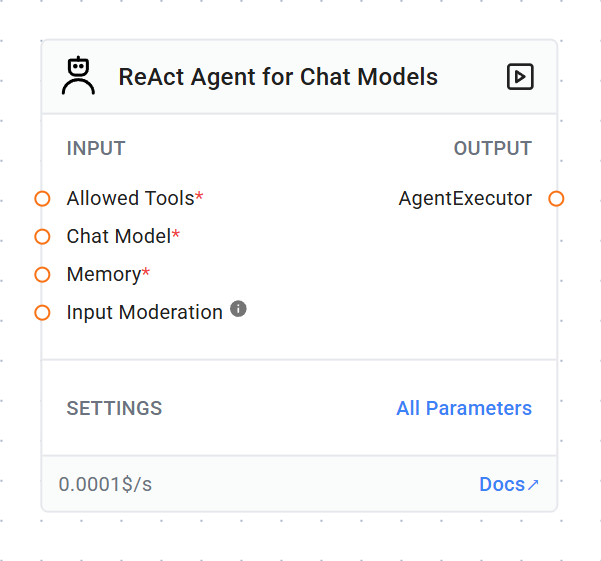Skip to main content
Node Details
-
Name:
reactAgentChat
-
Type:
AgentExecutor
-
Category: Agents
Description
This agent implements the ReAct (Reason + Act) framework, which allows it to alternate between reasoning about a problem and taking actions to solve it. It’s designed to work seamlessly with chat models, making it particularly effective for interactive, multi-turn conversations that involve complex problem-solving.
Parameters
-
Allowed Tools (Required)
-
Type: Tool[]
-
Description: A list of tools that the agent can use to perform tasks or gather information.
-
Chat Model (Required)
-
Type: BaseChatModel
-
Description: The chat model used for generating responses and making decisions.
-
Memory (Required)
-
Type: BaseChatMemory
-
Description: The memory component used to store and retrieve conversation history.
-
Input Moderation (Optional)
-
Type: Moderation[]
-
Description: Moderation tools to detect and prevent harmful input.
-
Max Iterations (Optional)
-
Type: number
-
Description: The maximum number of reasoning-action cycles the agent will perform for a single input.
-
Additional Params: true
- A string containing the user’s message or query.
Output
-
A string or object containing the agent’s response, which may include:
-
The final answer or solution to the user’s query
-
Intermediate steps of reasoning and actions taken
-
Any relevant information gathered during the process
How It Works
-
The agent is initialized with the provided tools, chat model, memory, and optional parameters.
-
It receives a user input, which is first checked by any specified moderation tools.
-
The agent then enters a loop of reasoning and acting:
-
It analyzes the current state and the task at hand
-
Decides on the next action (which may involve using a tool)
-
Executes the action and observes the result
-
Updates its understanding based on the action’s outcome
-
This loop continues until the agent reaches a conclusion or hits the maximum number of iterations.
-
The final response is generated, incorporating the reasoning process and results.
-
The conversation history is updated in the memory for future context.
Use Cases
-
Complex problem-solving in a conversational context
-
Multi-step task execution with explanations
-
Interactive tutoring or educational systems
-
Research assistants that can reason and gather information
-
Customer support systems for complex inquiries
-
Analytical tools that require both data processing and natural language interaction
Special Features
-
ReAct Framework: Implements the Reason + Act loop for sophisticated problem-solving.
-
Chat Model Optimization: Specifically designed to work well with chat models for natural conversations.
-
Tool Integration: Can use a variety of tools to enhance its capabilities and perform actions.
-
Memory Management: Maintains conversation history for contextual understanding.
-
Moderation: Can implement input moderation to ensure safe interactions.
-
Vision Support: If the chat model supports vision capabilities, the agent can process and respond to image inputs.
-
Streaming: Supports streaming responses for real-time interaction.
Notes
-
The agent uses a sophisticated prompt structure that encourages step-by-step reasoning and action.
-
It can handle multi-modal inputs if the underlying chat model supports it (e.g., text and images).
-
The max iterations parameter can be used to control the depth of the agent’s problem-solving attempts.
-
This agent is particularly effective for tasks that require a combination of analytical thinking and information gathering or action execution.
The ReAct Agent for Chat Models provides a powerful solution for building AI systems that can engage in complex, multi-step problem-solving within a conversational framework. Its ability to reason about problems, take actions, and explain its thought process makes it suitable for a wide range of applications where both analytical capabilities and natural language interaction are important. 

